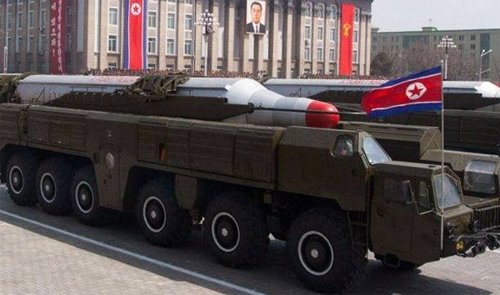Kim Jong Un loses face for the failed launch of Musudan IRBM
Kim Jong Un loses face for the failed launch of Musudan IRBM
Posted April. 16, 2016 07:14,
Updated April. 16, 2016 07:18

According to the South Korean military, the North fired one Musudan missile from a transporter erector launcher (TEL) in a site around Wonsan at about 5:30 a.m. on the day. It has been reported that the missile slanted unexpectedly from the early phase soon after the launch, failed to take flying posture, and exploited midair several hundred meters above the sea level.
A South Korean military source said, “The missile is believed to have developed a problem even before reaching the normal flying trajectory.” U.S. spy satellites detected such situation in real time, while the South Korean military also reportedly confirmed the failure by gathering signals of North Korea’s intelligence and eavesdropping communications. A South Korean military source said, “The South Korea-U.S. joint assessment has concluded the launch to be a failure.”
Earlier, the North deployed two to three TELs loaded with Musudan missiles around the Wonsan area from early this month, and displayed signs of imminent launch. Hence, the South Korean military authority prepared for the North’s provocative action by deploying Aegis destroyers to the East Sea, among other counteractions.
The Musudan missile capable of carrying a nuclear warhead has an estimated maximum range of 4,000 kilometers. It could reach as far away as Andersen Air Force Base on Guam where the U.S. has its strategic weapons, including B-52 bombers. The missile was deployed to combat mission beginning in 2007, and the actual system was only made public for the first time during the military inspection marking the 65th anniversary of the communist nation's ruling Workers' Party in 2010.
However, since the missile had never been launched before, its performance and destructive power remained unknown. The South Korean and U.S. military authorities assessed that since the missile was a copycat of the Russian submarine launched ballistic missile (SLBM), R-27 (SS-N-6), the North was confident in its performance and reliability.
The U.S. has deployed the Terminal High Altitude Area Defense (THAAD) system at the Guam military base since 2009 in order to counter the threat of the North’s Musudan missile.
However, as the Musudan missile, which was launched to celebrate the Day of the Sun, ended in failure, North Korean leader Kim Jong Un has lost face quite a bit. This is because the failure has revealed without reservation the weakness of the Musudan missile, which was created by increasing the projectile of the R-27 SLBM and remodeling the engine.
A South Korean military source said, “It is highly likely that the missile exploded midair soon after launch due to a grave defect in the engine and the propellant.” Analysts say that the latest situation has also revealed limitations in the performance of the engine for ICBM and the solid fuel rocket, which the North disclosed in succession recently.
A South Korean military source said, “This is circumstantial evidence that suggests the situation of sloppy management of hundreds of ballistic missiles that are deployed across the North.” The North is also expected to severely discipline its technical team by holding it responsible for failure in the launch.
The South Korean military is preparing for the possibility that the North could launch an additional Musudan missile ahead of its seventh party convention next month in order to recover from the botched launch. This is because chances are high the North will seek to maximize the threat of its nuclear strikes against the U.S. by pushing ahead with a fifth nuclear test after succeeding in the launch of the Musudan missile. Currently, there are signs of operation of another TEL carrying a missile around the Wonsan area.
Japan responded sensitively to the North’s failure in Musudan missile launch. “Tokyo can never tolerate any act of provocation by Pyongyang,” Japanese Foreign Minister Fumio Kishida told reporters. “We will urge the North to refrain from provocation, in collaboration with South Korea and the U.S.”
윤상호군사전문기자ysh1005@donga.com sya@donga.com







